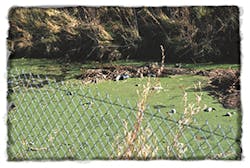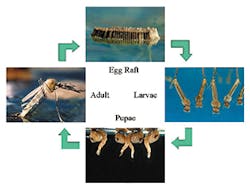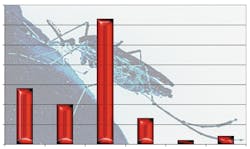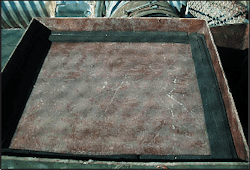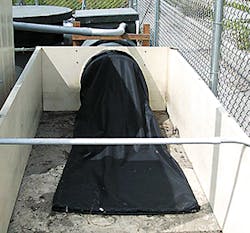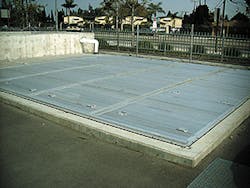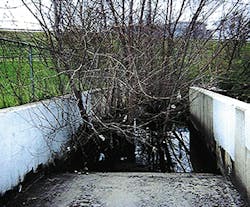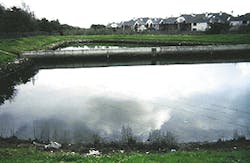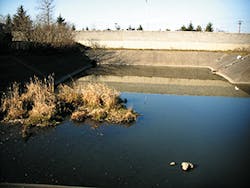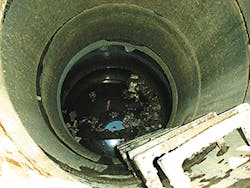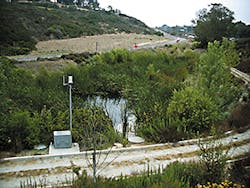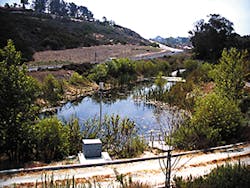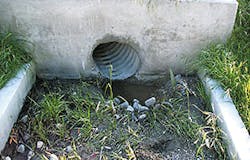It’s fascinating how our attitudes toward particular issues change over time, sometimes completely shifting direction. These changes are usually a direct result of an increase in awareness and knowledge of a particular subject matter, which in turn influences changes in priorities, values, and opinions. A dramatic and rapid evolution has been occurring with regard to the health of the nation’s waters and their surrounding environments over the past half century. There has been increasing awareness of the value of our water resources for a wide variety of reasons, including recreation, aesthetics, critical wildlife habitat, and the important environmental functions they provide.
A significant portion of recovery and mitigation plans promulgated by the enforcement of the Clean Water Act requires massive reductions in the quantity of pollutants and sediments that enter receiving waters. One of the primary strategies being used to achieve these goals is the use of structural, nonstructural, and managerial techniques, or best management practices (BMPs), recognized to be the “most effective and practical means” of reducing water contamination while still allowing the productive use of resources. Unfortunately, the strategies to achieve clean-water goals are extensive and complex and have many obstacles.
One issue associated with modern water-related programs that has not received much attention until recently is the potential public health risk created by the use of certain BMPs. If not designed and managed properly, restored or created wetland habitats and pollution- and flood-control devices can provide abundant habitat for the propagation of mosquitoes and other vectors within major urban areas. This is an issue of prime concern because of the existing and widespread presence of endemic vector-borne diseases and the continual invasion of exotic vectors and pathogens. In addition, we have entered an era in which most of the pesticides that once provided us with protection from these disease-transmitting organisms have either become ineffective or are being removed from use through litigation and legislation. Statistically, as vector populations increase, so does the risk of disease transmission.
So, What the Heck Are Vectors?
When they hear talk of “vectors,” many people think of physics. Broadly defined, a vector is a quantity that has magnitude and direction and that is commonly represented by a directed line segment whose length represents the magnitude and whose orientation in space represents the direction. When used in biological terms, however, a vector refers to any organism that can transmit an infectious disease pathogen to another organism. As in physics, the vector and its associated pathogens also have magnitude and direction. The ability of the vector to transmit disease is analogous to magnitude, whereas the disease pathogen travels in a direction, represented by a line, from the vector to a new organism. Infections acquired from vectors are referred to as vector-borne diseases.
(St. Louis encephalitis virus)
Figure 1 shows a typical vector-borne disease cycle: the St. Louis encephalitis (SLE) virus, a common pathogen in the United States. Certain species of mosquitoes can pick up virus particles by biting infected birds and later can transmit them to uninfected birds, maintaining the disease cycle in nature. These birds are generally not harmed by the virus and serve as the disease reservoirs. Unfortunately, infected mosquitoes also bite other animals. In humans, infection with SLE virus can cause a serious and potentially fatal inflammation of the brain.
Dozens of diseases, many of which are harmful or fatal to humans, are transmitted by hundreds of vector species worldwide. These diseases are caused by a wide variety of pathogens, including viruses (e.g., dengue, yellow fever, West Nile virus), bacteria (e.g., Lyme disease, babesiosis, plague), protozoa (e.g., malaria), and nematodes (e.g., dog heartworm). Vectors that frequently get media attention in the US include mosquitoes, ticks, and fleas.
Mosquitoes are the world’s most significant vectors. Diseases transmitted by mosquitoes are responsible for the deaths of millions of people every year. Nonfatal infections can cause severe and debilitating illness that, if widespread, can affect local economies by reducing the number of available people in the work force and increasing the cost of health care. Based on global estimates by the World Health Organization, each year 50 million cases of dengue are diagnosed (24,000 deaths), as are 200,000 cases of yellow fever (30,000 deaths) and 300 million to 500 million cases of malaria (more than 1 million deaths). Fortunately, not all mosquitoes transmit disease; however, some species can become so abundant that they might impact tourism, make residents miserable, and even kill small animals by literally sucking all their blood.
Mosquitoes form a group of extremely successful insects. Approximately 3,000 mosquito species have been described from around the world; the US is home to about 200 of these. Mosquitoes have adapted to practically every conceivable ecological niche, from the tropics to both the Arctic and Antarctic Circles, because of the tremendous variation in the biology and ecology of individual species. One unifying feature of this group is that they all have obligate aquatic larvae and pupae (immature stages); thus, they absolutely must have water to complete their life cycle. We humans also need water for survival (although we don’t raise our children in it), and our cities always provide abundant natural and artificial sources of water. As a result, mosquitoes thrive in our communities and surrounding habitats as unwelcome guests. In the US, mosquitoes are undoubtedly the most important urban vectors.
Figure 2. Mosquito Life Cycle
As shown in Figure 2, mosquitoes undergo a complete metamorphosis from aquatic larvae to winged adults. Eggs are laid in or near water and larvae and pupae are completely aquatic. Larvae feed on microscopic items, such as bacteria, and grow rapidly—eventually becoming pupae. Winged adults emerge from pupae, mate, and begin the cycle again. Only female mosquitoes feed on blood, which is used to provide the nutrients needed for the development of eggs. Males are more short-lived and feed on plant juices. It is because of their need for blood that mosquitoes have caused discomfort, suffering, and death throughout history.
The Unpleasant Relationship Between Mosquitoes and Humans
Mosquitoes have played a prominent role in the history of the US, both as pests and carriers of disease. Historically, many coastal regions of the US with salt marshes, swamps, or wetlands were uninhabitable during certain times of the year as a result of the presence of millions of mosquitoes. In addition, outbreaks of such diseases as malaria and yellow fever took a tremendous toll in human suffering and death and occasionally decimated developing cities and local economies. Interestingly, it was not until the very end of the 1800s that the role of mosquitoes, ticks, and other vectors as carriers of infectious diseases was discovered.
The early 1900s brought many changes with regard to public health. Widespread campaigns were implemented to eliminate disease-carrying mosquitoes. In 1910, successful malaria- and mosquito-control programs in California received widespread publicity, and throughout the country civic groups began to improve the overall health of their communities through organized mosquito control. The California state legislature passed the Mosquito Abatement Act of 1915, which allowed communities faced with serious mosquito problems to form their own regional abatement districts separate from other government agencies. Under the act, landowners or those responsible for water sources that supported the development of mosquitoes became responsible for abatement. Mosquito abatement districts had the authority, if necessary, to act on behalf of the district’s residents and, following a public hearing, could charge individual landowners for the costs of controlling mosquitoes on their property. The first mosquito-control district was officially launched in northern California in 1915, covering both Marin and Sonoma Counties. Today the state has 51 mosquito- and vector-control districts. In other states, similar scenarios ensued: for example, New Jersey created county mosquito-extermination commissions in 1912, and Florida’s first mosquito-control districts were created in 1925.
Early mosquito-control efforts focused on hand-ditching, diking, dredge and fill, and dewatering aquatic habitats to permanently eliminate breeding sources. Thousands of miles of ditches were built to drain salt marshes and other wetland habitats. This land was often converted for agricultural use or provided valuable and desirable real estate for developing towns and cities. Aquatic habitats that remained were periodically inspected and abated for mosquito larvae. Before the discovery of modern pesticides, abating mosquito larvae and pupae (larviciding) was effectively carried out by applying petroleum-based liquids, such as diesel oil and kerosene, to the water surface to create a suffocating oil layer. After World War II, pesticides became available, and DDT (dichlorodiphenyltrichloroethane) quickly became the material of choice for both adult and larval mosquito control. Initial results were good, and many believed this chemical was the answer to mosquito-control problems; however, mosquitoes rapidly developed resistance to DDT and many other closely related insecticides, making their use almost completely ineffective. In the decades that followed, many new classes of insecticides were developed for mosquito control, each with decreasing toxicity to the environment.
It was soon recognized that relying solely on chemicals for mosquito control was doomed to failure. In the 1950s, additional programs targeted permanent control of breeding sites through elimination of more aquatic habitats and the creation of many new mosquito-control programs. By the 1970s, disagreements began to arise among mosquito-control agencies and environmental agencies concerning such mosquito-control practices as wetland elimination. Today modern mosquito control is much more sophisticated. Integrated management practices combine several techniques, including the judicious use of environmentally friendly larvicides, biological control agents such as fish, and well-planned habitat management rather than habitat elimination. As harmful as some of the early ideologies and methodologies might seem to us today, many coastal cities and towns in places such as Florida, New Jersey, the Gulf Coast, and California owe their existence and success in large part to mosquito-control efforts.
The Existing Urban Mosquito Problem
Earlier we mentioned that wetland habitats, flood-control devices, and structural BMPs might provide suitable habitats for the propagation of mosquitoes in and around urban areas if not designed and managed properly; however, this is not to imply that mosquito problems don’t already exist. What we must understand is that the construction of new habitats has the potential to make an already bad situation worse.
The urban environment is filled with sources of standing water suitable for mosquito development. Even in arid areas of the Southwest that would normally not support many mosquitoes, humans have created urban oases using imported water and exotic plants. Urban environments provide mosquitoes with a vast array of new habitats: humid and arid, above and below ground, small water-holding containers and large ponds, polluted and clean water. Aquatic habitats are found around people’s homes (birdbaths, jars, flower pots, neglected pools and Jacuzzis, and clogged rain gutters), in unregulated waste dumps (used tires, barrels, bottles, and cans), in parks (ponds, lakes, and streams), and in the city’s own infrastructure (storm drains, sewer systems, catch basins, and culverts). Many of these sources are replenished frequently by stormwater and urban runoff (e.g., irrigation, washing cars). Adding to this, increasingly stringent urban stormwater runoff regulations have recently mandated the construction of structural BMPs for both volume reduction and pollution management, many of which have created additional sources of standing water. This abundance of habitats has favored mosquitoes and allowed many species to greatly expand their range and increase in number.
Aquatic habitats are chosen and utilized by different mosquito species based on many factors, including nutritional requirements of the larvae, egg-laying behavior of adult females, and location. Any source of standing water, however, will usually provide suitable habitat for at least some mosquito species. Unfortunately, opportunistic mosquito species likely to breed in urban sources are often important vectors of human and animal diseases. Many mosquito larvae can develop in extremely shallow water and might even survive short periods of time without water as long as the environment remains moist. Complete development from egg to adult can occur in less than one week, allowing mosquito populations to increase at alarming rates under optimal conditions.
There are two basic groups of mosquitoes that may utilize aquatic habitats in the urban environment: permanent water species and floodwater species. Permanent water species lay their eggs directly on the water surface or on the leaves of aquatic plants. Floodwater species deposit eggs on moist soil or the substrate around aquatic systems, and the eggs hatch only when submerged by rising water levels. These behavioral and biological differences have major impacts on the species that use different manmade structures. For example, floodwater mosquitoes will seldom be attracted to structures, such as retention ponds, that experience minimal or infrequent water-level fluctuations. However, structures such as extended detention basins that frequently fill and empty provide the requirements they need.
Vectors and BMPs: Results of a Nationwide Investigation
In 1998, the California Department of Health Services’s Vector-Borne Disease Section (VBDS) entered into an agreement with the California Department of Transportation (Caltrans) to provide technical expertise regarding vector issues within its stormwater BMP Retrofit Pilot Study (described in detail in the March/April 2001 issue of Stormwater). As part of the overall pilot study, VBDS conducted a two-year study of vector production associated with the 37 operational stormwater BMP structures in southern California, in collaboration with local vector-control agencies and stormwater management consultants. Before this study, little or no information was available on the actual or potential vectors associated with these kinds of structures. To enhance the study and obtain further information, an extensive nationwide investigation was conducted. The primary objectives were to develop an understanding of the relationship between vectors and stormwater management structures (BMPs) and to gather information on solutions (besides traditional mosquito control using larvicides) used to prevent, reduce, or eliminate vectors from these sites.
More than 150 agencies in 28 states were contacted by phone or mail or visited in person. These included a wide variety of state, county, and municipal agencies representing vastly different interests, such as vector control, public works, transportation, and environmental issues. In addition, contacted agencies were located in areas with dramatically different climates, ecosystems, and population densities. The data collected allowed a preliminary assessment of the potential public health risks from mosquitoes and other vectors associated with stormwater BMPs or BMP-like structures. Few agencies had experience with novel preventative measures against vectors within structures, but many provided important information describing factors that encouraged vector production.
The results of the investigation left no question that a variety of vector species, particularly mosquitoes, utilize the habitats created by stormwater BMP structures throughout the US (Figure 3). For example, of 72 agencies that completed a VBDS questionnaire, 86% reported mosquito production associated with local BMPs. At least six groups (genera) of mosquitoes have been identified, representing several dozen species. Other species, including midges, rodents, black flies, and cockroaches, were also reported from certain stormwater management structures. Midges, nuisance insects that can cause allergy problems in sensitive people, were the most common species breeding in BMP structures, second only to mosquitoes. Unexpected findings from the study included the discovery that in Portland, OR, beaver systematically “reengineer” retention structures to serve their needs rather than allowing them to perform their intended function, and in Florida, “pollutants” collected by stormwater structures sometimes include snakes and alligators.
Overall, a variety of stormwater BMP structures were implicated as significant sources of vectors. Unfortunately, it was impossible to accurately assess the relative importance of one design over another with regard to vector production without detailed studies. However, the mosquito production study conducted in southern California provided data to make a qualitative and quantitative preliminary assessment of vector production within many different stormwater BMP structures.
Vectors and the Caltrans BMP Retrofit Pilot Study
In 1997, Caltrans began an extensive program plan to retrofit 33 selected facilities with 39 structural BMPs to improve water quality in Los Angeles and San Diego Counties. Eight categories of BMPs were constructed: (1) biofiltration strips and swales; (2) filtration devices (Austin-type and Delaware-type sand media filters, multichambered treatment train sand media filters (MCTT), StormFilter canister filter by Stormwater Management Inc.); (3) extended detention basins; (4) infiltration devices (basins and trenches); (5) continuous deflective separators (CDS) by CDS Technologies Inc.; (6) an oil/water separator; (7) drain-inlet inserts (Fossil Filter by KriStar Enterprises Inc. and Stream Guard by Foss Environmental); and (8) a constructed wetland (retention pond). VBDS coordinated a comprehensive vector surveillance and monitoring study in collaboration with four southern California mosquito- and vector-control agencies and stormwater management consultants to identify which stormwater BMP designs were least conducive to vector production. During the study, modifications to BMP structures were recommended in an attempt to reduce or eliminate their potential to produce or harbor vectors. Weekly monitoring data were used to make short-term assessments regarding the efficacy of the modifications. It was anticipated that the outcome of this study would have significant implications on methods that may be mandated for the proper management of stormwater runoff.
During the two-year study, mosquitoes were the dominant vector species present within Caltrans BMP structures. (Occasionally, presence or evidence of other vector and nuisance species was observed, including rodents, cockroaches, and midges.) Eight mosquito species were found breeding in BMP structures, four of which are known vectors of human disease. Of the eight different BMP technologies implemented by Caltrans, those that maintained permanent sources of standing water in sumps or basins (i.e., MCTT, CDS, and the retention pond) provided excellent habitat for immature mosquitoes and frequently supported large populations relative to other structural designs. In contrast, BMPs designed to drain rapidly (i.e., biofiltration swales and strips, Austin-type sand media filters, infiltration basins and trenches, and extended detention basins) provided less suitable habitats and rarely harbored mosquitoes.
Designing and Building a Better BMP
Times are changing rapidly in the field of vector prevention and control. The number of pesticides available for mosquito control are dwindling fast, and biological-control agents (e.g., mosquito fish) often have limited application. Neither approach generally provides a long-term solution. The best solution to minimizing vector production is through prevention, by “engineering them out” of structural devices and enforcing proper and regular maintenance. The following criteria should be considered in the design of all structural BMPs to reduce the probability of mosquito breeding and allow for routine vector surveillance (or abatement if necessary) and maintenance.
Dry Systems
1. Structures should be designed such that they do not hold standing water for more than 72 hours to prevent mosquito development. Provisions to prevent or reduce the possibility of clogged discharge orifices (e.g., debris screens) should be incorporated into the design. The use of weep holes is not recommended due to rapid clogging.
2. The hydraulic grade line of each site should be a primary factor in determining the appropriate BMP that will allow water to flow by gravity through the structure. Pumps are not recommended because they are subject to failure and often require sumps that hold water. Structures that do not require pumping should be favored over those that have this requirement.
3. Designs should avoid the use of loose riprap or concrete depressions that can hold standing water.
4. Distribution piping and containment basins should be designed with adequate slopes to drain fully and prevent standing water. The design slope should take into consideration
buildup of sediment between maintenance periods.
5. The use of barriers or diversions that results in standing water should be avoided.
Systems With Sumps or Basins
1. Structures designed with sumps or basins that retain water permanently or longer than 72 hours (e.g., CDS, Delaware-type sand media filters) should be sealed completely to prevent entry of adult mosquitoes. Adult female mosquitoes can use openings as small as 1/16 in. to access water for egg laying. Screening can be used to exclude mosquitoes but is subject to damage and is not a method of choice.
2. Structures should be designed with the appropriate pumping, piping, valves, or other necessary equipment to allow for easy dewatering of the unit if necessary.
3. If the sump or basin is completely sealed, with the exception of the inlet and outlet, the inlet and outlet should be fully submerged to reduce the available surface area of water for mosquitoes to lay eggs (female mosquitoes can fly through pipes).
Permanent Ponds
1. Permanent ponds should maintain water quality sufficient to support surface-feeding fish such as mosquito fish (Gambusia affinis), which feed on mosquito larvae.
2. Permanent pond shorelines should be accessible to both maintenance and vector-control crews for (1) periodic maintenance and/or control of emergent and pondedge vegetation and (2) routine monitoring of mosquito immatures and abatement procedures if necessary. Emergent plant density should be controlled so that mosquito predators are not inhibited or excluded from pond edges (i.e., fish should be able to swim between plant bases).
3. If possible, permanent ponds should be maintained with depths in excess of 4 ft. to preclude invasive emergent vegetation such as cattails. Emergent vegetation provides mosquito larvae with refuge from predators and increases nutrient availability. The pond edges below the water surface should be as steep as practicable and uniform to discourage dense plant growth and reduce favorable mosquito habitat.
4. Concrete or liners should be used in areas where vegetation is not necessary to prevent unwanted plant growth.
5. Permanent ponds should be designed to allow for easy dewatering of the basin when needed.
General-Access Requirements
1. All BMP structures should be easily and safely accessible, without the need for special requirements (e.g., Occupational Safety & Health Administration requirements for “confined space”). This will allow vector-control personnel to effectively monitor and, if necessary, abate vectors.
2. If covers are used, the design should include springloaded or lightweight access hatches that can be opened easily. Covers should seal completely.
3. All-weather road access (with provisions for turning a full-size work vehicle) should be provided along at least one side of large aboveground BMPs that are less than 7 m wide. BMPs that have shoreline-to-shoreline distances in excess of 7 m should have a perimeter road for access to both sides. (Mosquito larvicides are applied with handheld equipment at small sites and with backpack or truck-mounted high-pressure sprayers at large sites. The effective swath width of most backpack or truck-mounted larvicide sprayers is approximately 7m on a windless day.)
4. Access roads should be built as close to the shoreline as possible. It is important to not have vegetation or other obstacles between the access road and the BMP that might obstruct the path of larvicides to the water.
5. Vegetation should be controlled (removal, thinning, or mowing) periodically to prevent access barriers
Design Recommendations: Permanent or Temporary Solutions?
Design features and other factors that created suitable habitat for the propagation of vectors within BMPs were addressed, and corrective and/or preventive recommendations for future designs were provided. In addition, factors that inhibited vector surveillance and abatement efforts in and around BMP structures were also addressed. During the two-year study, numerous design features and operational breakdowns resulted in standing water within BMP structures for various lengths of time. Consequently, these habitats were usually found to be supporting mosquito larvae within a few days of accumulating water. Caltrans attempted to resolve the design issues that allowed vector breeding based on recommendations made by VBDS and the local vector-control districts, and it implemented these solutions to many of the BMPs. The short-term evaluation of the “vector-proofing” efforts made by Caltrans to certain BMPs has been promising. Continued monitoring of these structures will determine if these modifications provide permanent or temporary solutions.
sites since October 1999.
Importance of Proper Design and Maintenance
One of the primary concerns of vector-control personnel is the potential for the progressive decline or maintenance failure of BMP structures over time. Stormwater BMP structures are subject to myriad physical and environmental factors that can contribute to reduced performance or complete failure. Poor performance and failure not only defy the purpose of building these structures, but they also frequently result in sources of standing water that can harbor vectors, particularly mosquitoes. Agencies that contributed to the nationwide BMP/vector study discussed earlier provided information on structures that had been in service for years, sometimes decades. Not surprisingly, one of the primary concerns from engineers and vector-control personnel was irregular maintenance or complete lack of maintenance. Regardless of the reasons for this (public works agencies being understaffed, underfunded, and so on), the lack of emphasis on maintenance resulted in a breakdown in constituent and trash removal efficacy and was a main factor contributing to vector production.
Two main factors contribute to the suitability of BMP structures to produce vectors: design and maintenance. Conceptually, some BMP designs might look and function great on paper but might not be “adaptable” to changing environmental conditions, both short term and long term. In general, any design that includes standing water or requires more than 72 hours to drain will eventually become a source of mosquitoes and other vectors. From years of research and field observations, vector-control personnel throughout the country have found that aquatic habitats that last only three to five days generally do not permit complete development of mosquito larvae. As a result, in California and many other states, the general recommendation has been for structures to drain completely in 72 hours or less. This alone, if applied to all BMPs, could prevent vector production by eliminating the habitat needed by larvae.
Unfortunately, without proper maintenance, even the most “perfect” stormwater BMP designs will eventually degrade and witness a deterioration in pollutant-removal efficiency. Stagnant water that might accumulate in these structures will likely have high concentrations of organic material and be attractive to egg-laying female mosquitoes. These habitats are also usually free of predators. Structural damage over time can reduce BMP performance and create standing water. In addition, the accumulation of vegetation, silt, and debris within structures is inevitable and is the primary reason why they must be maintained to prevent the occurrence of standing water. Emergent vegetation can completely overrun and clog retention ponds that are not deeper than 3-4 ft., and even concrete-lined structures will fill with sediment, providing a matrix for roots of opportunistic plants to grow, which might lead to further clogging. In addition, BMPs built in urban areas usually receive large quantities of nonstormwater runoff (e.g., from landscape irrigation, residential pool cleaning, washing vehicles), which can contribute to vector production by prolonging the occurrence of water within these structures. In general, it is recommended to plan for routine inspections of all BMP structures to prevent the unexpected.
Finally, location and climate must always be taken into consideration when building stormwater BMPs. Rainfall data are important in design, but an understanding of environmental and biological factors of the surrounding area are equally important. A knowledge of basic local biology and ecology will help in designing and building the best BMP for a given location. The presence of certain plants and animals should influence design factors.
Lessons Learned
One of the most important lessons learned from the nationwide study was the recognition of the huge number of agencies nationwide that are involved with some aspect of stormwater runoff management. Based on the size and scope of the many stormwater programs, it is clear that vector issues have yet to be adequately addressed. It is important to realize that the thousands of currently deployed and planned structural BMP devices across the country will provide new breeding habitat for mosquitoes and other vectors. This might result in an increase in the number of local vector species and might provide habitat for exotic species to become established. Several agencies in Maryland, New Jersey, and Virginia reported that the rapid spread of West Nile virus, transmitted by mosquitoes, is causing them to rethink some of their BMP strategies. Even if individual BMP structures produce only a small number of vectors, the cumulative impact from a large number of “small” breeding sites could produce large numbers of vectors and create significant health risks.
The contributions made by participating agencies in this study provided a wealth of information on both BMP structures and their associated vector issues in widely disparate regions of the US. These results leave little doubt that many stormwater management structures can and do provide suitable habitats for vectors, with both local and exotic vector species utilizing them for reproduction. Determining how to best manage vectors in the potentially large number of BMP structures will take time, but will depend largely on the operation and maintenance plans for these structures. Unfortunately, the study clearly demonstrated that these issues have yet to be thoroughly examined. Because of the constant pressure to meet EPA stormwater program deadlines, “crisis management” seems to be the current maintenance paradigm used by many agencies across the country. This is clearly not a suitable long-term solution. Regular and appropriate maintenance is required to both preserve the intended level of BMP performance and reduce or eliminate the production of vectors. Many participating agencies felt it inevitable that some sort of new local stormwater utility agencies must be established to regularly manage and maintain BMPs. It also seems clear that the initial costs of structural BMP construction are insignificant when compared to the large financial burdens necessary to provide the routine maintenance required to keep structures functioning properly over several years or even decades.
To date, few studies have addressed vector issues in artificial habitats created by structural BMPs built specifically for reducing nonpoint-source pollution in stormwater runoff. Results from the two-year study with Caltrans BMP structures indicate that much research remains to be conducted to better satisfy water-quality improvement goals while preventing vector production. The study found that vector production in the Caltrans BMPs was influenced not only by specific design features but also by location, immediate and distant land use, nonstormwater discharges (e.g., irrigation runoff), site maintenance, and various other unexpected events. Therefore, direct comparisons among structures of similar design were difficult. However, general design features that contributed to vector production were identified: (1) the use of sumps, catch basins, or spreader troughs that did not drain completely; (2) the use of loose riprap; (3) pumps or motors designed to “automatically” drain water from structures; and (4) effluent pipes with small-diameter discharge orifices prone to clogging. Data also suggest that BMP structures can support additional vector species as they age and “mature” over time.
Final Thoughts
Managing vectors in stormwater BMPs is an urgent need that must be addressed. Rapid construction and poor interagency communication and cooperation place an increasing burden upon vector-control agencies, most of which have very limited resources. The fact that widely different opinions exist as to which BMP structures are most appropriate to a given application or specific site illustrates that BMPs are probably being constructed at rates exceeding our understanding of the long-term implications of their use. Some agencies are encouraging the use of nonstructural BMPs that provide performance similar to that of structural BMPs while reducing cost and maintenance, though these might not be suitable for all applications.
There is also a pressing need for increased communication and collaboration between agencies interested in promoting water-quality improvement and local and state-level vector-control agencies. Many vector-control agencies have expressed interest in being involved in the design and implementation of stormwater BMPs in their local areas. It seems clear that some structures could have been improved if vector issues had been considered prior to construction. Local and state vector-control personnel should be directly involved in development and implementation of BMPs for the construction and maintenance of economically efficient, biologically acceptable, and environmentally compatible stormwater management structures. Vector-control agencies can provide valuable information on the biology and ecology of the local area and make design recommendations that minimize vector production. This input can help create structures that reduce public health risks with only minimal, if any, decreases in BMP pollutant-removal efficiency. This proactive rather than reactive approach to preventing potential vector problems will ultimately result in cost savings, minimize long-term vector production and associated surveillance and control, and ensure compliance with health and safety codes.
and maintain the function of the BMP.
Currently, stormwater BMP structures are designed with emphasis on minimizing operational oversight and maintenance. For instance, VBDS and local vector-control agencies throughout California currently recommend against the construction of stormwater BMP structures that hold permanent or semipermanent sources of standing water; however, it is understood that some designs require this for water-quality purposes and/or for proper operation. Therefore, it is critical that operation and maintenance protocols that reduce or prevent vector production should be incorporated into operation and maintenance manuals. Adequate funding for plan review, structure maintenance, and vector surveillance and control activities should be secured before BMP construction. Continued cooperation between agencies responsible for construction and/or maintenance of stormwater management structures and vector-control agencies will be needed to ensure that public health is not compromised.
We hope this article provides those working to improve our nation’s water quality with an understanding of the potential public health risks associated with aquatic habitats in the US. The benefits of improving water quality cannot be contested; however, in the process of achieving these goals, we should not compromise our own health and safety. The fact remains that certain aquatic habitats support blood-sucking mosquitoes and other vector species that have caused the death of countless millions of people worldwide from the many diseases they transmit. The diseases that we have subdued and eliminated from our country have the potential to become reestablished if we are not cautious with our approach to water and habitat restoration. The addition of thousands of new stormwater management structures could eventually result in vector populations that equal or exceed historical levels.
